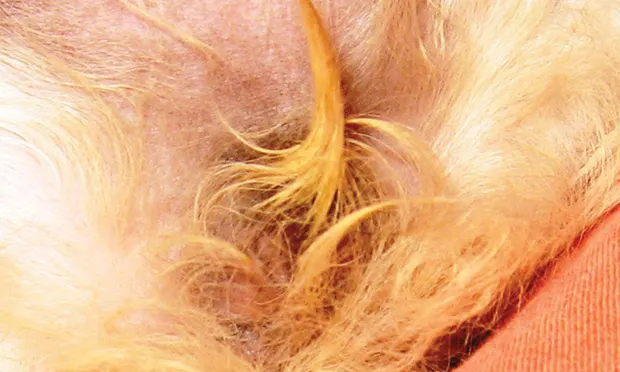Vulvar Discharge in a Puppy
Autumn P. Davidson, DVM, MS, DACVIM, University of California, Davis

At examination, a tan mucoid vulvar discharge was noted, along with matted fur in the perivulvar area.
An apparently healthy Labrador retriever puppy presented with a mucoid vulvar discharge.
History
The owners reported that the patient, an intact female 8 weeks of age, was mostly housebroken, but they were uncertain if her urinary behaviors were abnormal, as the puppy would urinate outdoors and then again in the house. The patient had been acquired a week previously and had received a single DA2PP vaccination; she received no medications.
Physical Examination
The puppy appeared normal at presentation (101.2°F, heart rate 130 bpm, panting respiratory rate). Tan mucoid vulvar discharge and some matted fur were evident in the perivulvar area. Perivulvar dermatitis was not apparent (Figure 1, above). Urination was observed and appeared normal. There was no evidence of pollakiuria, dysuria, stranguria, or gross hematuria.
Laboratory Diagnostics
Urine (obtained via cystocentesis) was submitted for urinalysis and urine culture pending evidence of cystitis on sediment examination. Urine-specific gravity was 1.023, urine sediment was benign, and culture was not indicated nor submitted. Cytology of the vulvar discharge was suppurative, revealing numerous nondegenerate neutrophils (Figure 2).

Cytology of vulvar discharge was suppurative with numerous nondegenerate neutrophils. (Modified Wright stain; 40× original magnification)
Diagnosis
Puppy Vaginitis
Causes
The cause of puppy vaginitis is currently unknown, although an imbalance of juvenile vaginal glandular epithelium is postulated. The condition can resolve at puberty or after ovariohysterectomy, but both represent different endocrine-mediated events and neither is likely to result in resolution. Puppy vaginitis, however, does diminish with maturity.
The term puppy vaginitis is a misnomer, as it is asymptomatic and not an inflammatory process causing clinical signs.
Presentation
The discharge, usually white to yellow or green and sometimes copious, can be accompanied by mild perivulvar dermatitis. Typically, a puppy is not attentive to the discharge, and although no associated change in urinary behavior (eg, dysuria, stranguria, pollakiuria) was reported in this case, clients often have difficulty deciding whether a puppy with vaginitis is exhibiting normal urinary behavior. Age of onset ranges from 6 weeks to puberty; the duration ranges from days to months and is often intermittent.
Treatment
Cleansing the perivulvar area with a gentle solution (eg, nonalcoholic otic preparation) or gentle wipes (eg, baby wipes) to prevent accumulation of discharge was advised. Adding a probiotic such as Enterococcus faecium (eg, FortiFlora, purinaveterinarydiets.com) may be beneficial.
Outcome
The discharge resolved with time.